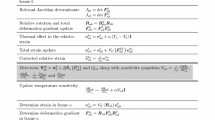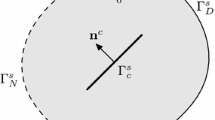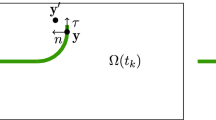Abstract
We propose an alternative crack propagation algorithm which effectively circumvents the variable transfer procedure adopted with classical mesh adaptation algorithms. The present alternative consists of two stages: a mesh-creation stage where a local damage model is employed with the objective of defining a crack-conforming mesh and a subsequent analysis stage with a localization limiter in the form of a modified screened Poisson equation which is exempt of crack path calculations. In the second stage, the crack naturally occurs within the refined region. A staggered scheme for standard equilibrium and screened Poisson equations is used in this second stage. Element subdivision is based on edge split operations using a constitutive quantity (damage). To assess the robustness and accuracy of this algorithm, we use five quasi-brittle benchmarks, all successfully solved.





















Similar content being viewed by others
References
Moës N, Dolbow J, Belytschko T (1999) A finite element method for crack growth without remeshing. Int J Numer Methods Eng 46:131–150
Oliver J (1995) Continuum modelling of strong discontinuities in solid mechanics using damage models. Comput Mech 17:49–61
Henshell RD, Shaw KG (1975) Crack tip elements are unnecessary. Int J Numer Methods Eng 9:1727–1742
Lasry D, Belytschko T (1988) Localization limiters in transient problems. Int J Solids Struct 24:581–597
Bittencourt TN, Wawrzynek PA, Ingraffea AR, Sousa JL (1996) Quasi-automatic simulation of crack propagation for 2D LEFM problems. Eng Fract Mech 55(2):321–334
Colombo D, Giglio M (2006) A methodology for automatic crack propagation modelling in planar and shell fe models. Eng Fract Mech 73:490–504
Karihaloo BL, Xiao QZ (2003) Modelling of stationary and growing cracks in FE framework without remeshing: a state-of-the-art review. Comput Struct 81:119–129
Loehnert S, Belytschko T (2007) A multiscale projection method for macro/microcrack simulations. Int J Numer Methods Eng 71:1466–1482
Moës N, Belytschko T (2002) Extended finite element method for cohesive crack growth. Eng Fract Mech 69:813–833
Nguyen-Xuan H, Liu GR, Nourbakhshnia N, Chen L (2012) A novel singular ES-FEM for crack growth simulation. Eng Fract Mech 84:41–66
Pierard O, Jin Y, Wyart E, Dompierre B, Bechet E (2016) Simulation of contact on crack lips and its influence on fatigue life prediction. In: Carpintieri A, Fatemi A, Navarro C (eds) International Conference on Multiaxial Fatigue and Fracture, ICMFF11, Seville. Fracture and structural integrity
Alfaiate J, Wells GN, Sluys LJ (2002) On the use of embedded discontinuity elements with crack path continuity for mode-I and mixed-mode fracture. Eng Fract Mech 69:661–686
Hansbo A, Hansbo P (2004) A finite element method for the simulation of strong and weak discontinuities in solid mechanics. Comput Methods Appl Mech Eng 193:3523–3540
Areias P, Rabczuk T (2013) Finite strain fracture of plates and shells with configurational forces and edge rotations. Int J Numer Methods Eng 94:1099–1122
Miehe C, Gürses E (2007) A robust algorithm for configurational-force-driven brittle crack propagation with \(r-\)adaptive mesh alignment. Int J Numer Methods Eng 72:127–155
Duflot M, Nguyen-Dang H (2004) A meshless method with enriched weight functions for fatigue. Int J Numer Methods Eng 59:1945–1961
Barbieri E, Petrinic N (2014) Three-dimensional crack propagation with distance-based discontinuous kernels in meshfree methods. Comput Mech 53(2):325–342
Peng X, Atroshchenko E, Kerfriden P, Bordas SPA (2016) Isogeometric boundary element methods for three dimensional static fracture and fatigue crack growth. Comput Methods Appl Mech Eng (in press)
Paulus CJ, Untereiner L, Courtecuisse H, Cotin S, Cazier D (2015) Virtual cutting of deformable objects based on efficient topological operations. Vis Comput 31:831–841
Bouchard PO, Bay F, Chastel Y (2003) Numerical modeling of crack propagation—implementation, techniques and comparison of different criteria. Comp Methods Appl Mech Eng 192(35–36):3887–3908
El Khaoulani R, Bouchard PO (2012) An anisotropic mesh adaptation strategy for damage and failure in ductile materials. Finite Elem Anal Des 59:1–10
Teng X, Wierzbicki T (2006) Evaluation of six fracture models in high velocity perforation. Eng Fract Mech 73:1653–1678
Oliver J (1989) A consistent characteristic length for smeared cracking models. Int J Numer Methods Eng 28:461–474
Etse G, Willam K (1999) Failure analysis of elastoviscoplastic material models. J Eng Mech 125:60–69
Schreyer HL, Chen Z (1986) One-dimensional softening with localization. J Appl Mech 53:791–797
Areias P. Simplas. http://home.uevora.pt/~pmaa/SimplasWebsite/Simplas.html
Lemaitre J (1996) A course on damage mechanics, 2nd edn. Springer, New York
Fetter AL, Walecka JD (2003) Theoretical mechanics of particles and continua. Courier Dover, New York
Ogden RW (1997) Non-linear elastic deformations. Dover Publications, New York
Mazars J (1984) Application de la mécanique de l’endommagement au comportement non linéaire et à la rupture du béton de structure. Thèse de Doctorat d’Etat, Université Paris VI, Paris
Peerlings RHJ, de Borst R, Brekelmans WAM, de Vree JHP (1996) Gradient enhanced damage for quasi-brittle materials. Int J Numer Methods Eng 39:3391–3403
Areias P, Dias-da-Costa D, Alfaiate J, Júlio E (2009) Arbitrary bi-dimensional finite strain cohesive crack propagation. Comput Mech 45(1):61–75
Areias PMA, César de Sá JMA, Conceição CA (2003) A gradient model for finite strain elastoplasticity coupled with damage. Finite Elem Anal Des 39:1191–1235
de Borst R, Pamin J, Geers MGD (1999) On coupled gradient-dependent plasticity and damage theories with a view to localization analysis. Eur J Mech A 18:939–962
Geers MGD, de Borst R, Brekelmans WAM, Peerlings RHJ (1998) Strain-based transient-gradient damage model for failure analysis. Comput Methods Appl Mech Eng 160:133–153
Wolfram Research Inc. Mathematica (2007)
Korelc J (2002) Multi-language and multi-environment generation of nonlinear finite element codes. Eng Comput 18(4):312–327
Belytschko T, Liu WK, Moran B (2000) Nonlinear finite elements for continua and structures. Wiley, New York
Frey PJ, George P-L (2000) Mesh generation: application to finite elements. Hermes Science, Oxford
Areias P, Garção J, Pires EB, Barbosa JI (2011) Exact corotational shell for finite strains and fracture. Comput Mech 48:385–406
Winkler BJ (2001) Traglastuntersuchungen von unbewehrten und bew. Betonstrukturen auf der Grundlage eines objektiven Werkstoffgesetzes für Beton. PhD thesis, University of Innsbruck, Innrain 52, 6020 Innsbruck
Most T, Bucher C (2006) Energy-based simulation of concrete cracking using an improved mixed-mode cohesive crack model within a meshless discretization. Int J Numer Anal Met 31:285–305
Dumstorff P, Meschke G (2007) Crack propagation criteria. Int J Numer Anal Met 31:239–259
Erdogan F, Sih GC (1963) On the crack extension in plates under plane loading and transverse shear. J Bas Eng 85:519–527
Areias P, Msekh MA, Rabczuk T (2016) Damage and fracture algorithm using the screened poisson equation and local remeshing. Eng Fract Mech 158:116–143
Carol I, Prat PC, López CM (1997) Normal/shear cracking model: application to discrete crack analysis. J Eng Mech 123:765–773
Schlangen E (1993) Experimental and numerical analysis of fracture processes in concrete. PhD thesis, Delft
Alfaiate J, Simone A, Sluys LJ (2003) A new approach to strong embedded discontinuities. In: Bicanic N, de Borst R, Mang H, Meschke G (eds) Computational Modelling of Concrete Structures, EURO-C 2003. St. Johann im Pongau
Areias PMA, César de Sá JMA, Conceição António CA, Carneiro JASAO, Teixeira VMP (2004) Strong displacement discontinuities and Lagrange multipliers in the analysis of finite displacement fracture problems. Comput Mech 35:54–71
Dias-da-Costa D, Alfaiate J, Sluys LJ, Júlio E (2009) A discrete strong discontinuity approach. Eng Fract Mech 76(9):1176–1201
Arrea M, Ingraffea RA (1982) Mixed-mode crack propagation in mortar and concrete. Technical Report Report 81-13, Cornell University, Department of Structural Engineering
Areias PMA, Belytschko T (2005) Analysis of three-dimensional crack initiation and propagation using the extended finite element method. Int J Numer Methods Eng 63:760–788
Bocca P, Carpinteri A, Valente S (1991) Mixed mode fracture of concrete. Int J Solids Struct 27(9):1139–1153
Rabczuk T, Belytschko T (2004) Cracking particles: a simplified meshfree method for arbitrary evolving cracks. Int J Numer Methods Eng 61:2316–2343
Ruprecht D, Müller H (1998) A scheme for edge-based adaptive tetrahedron subdivision. In: Hege H-C, Polthier K (eds) Mathematical visualization: algorithms., Applications and numericsSpringer, Berlin, pp 61–70
Author information
Authors and Affiliations
Corresponding author
Rights and permissions
About this article
Cite this article
Areias, P., Rabczuk, T. & de Sá, J.C. A novel two-stage discrete crack method based on the screened Poisson equation and local mesh refinement. Comput Mech 58, 1003–1018 (2016). https://doi.org/10.1007/s00466-016-1328-5
Received:
Accepted:
Published:
Issue Date:
DOI: https://doi.org/10.1007/s00466-016-1328-5




